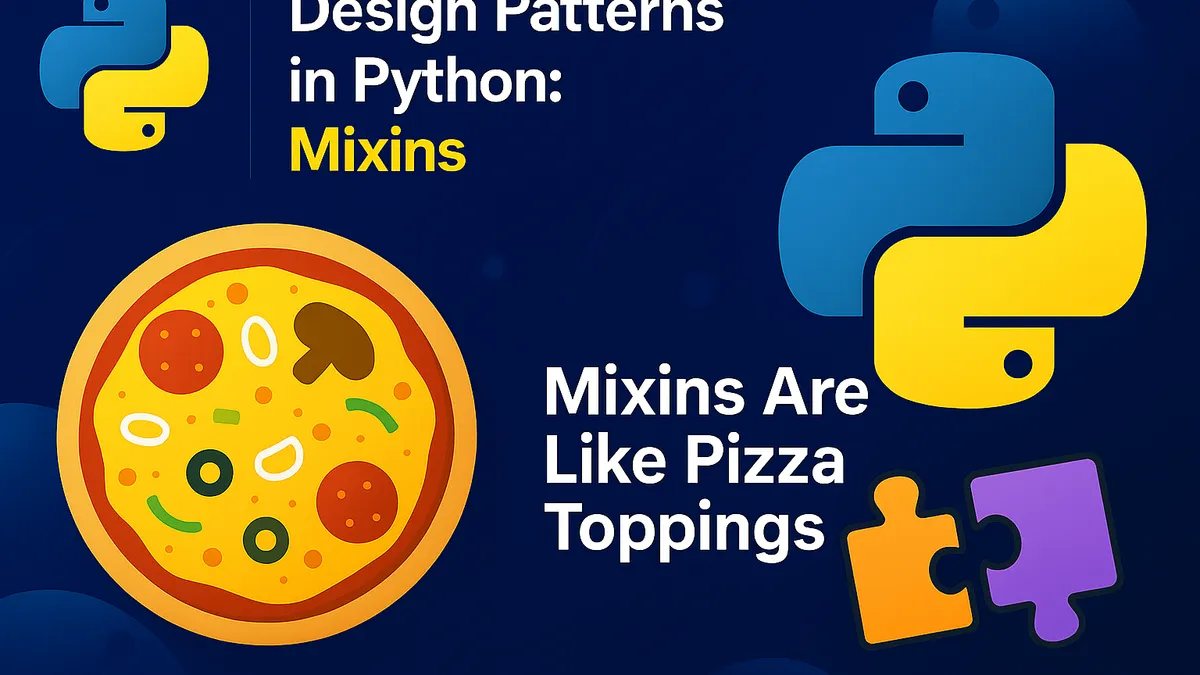
Understanding Python Mixins: What they are, what they aren't, and why you should use them
Learn how Python mixins solve code reuse challenges without the complexity of deep inheritance hierarchies. Discover when to use mixins vs static classes, best practices for stateless design, and real-world examples that make mixins click.
1. What is a Mixin? What is NOT a Mixin?#
Mixins are indeed like toppings in some ways - they're small, focused pieces of functionality that you can "sprinkle" onto your main classes to add specific behaviors without changing the core recipe.
Just like how you might add chocolate chips to cookies or nuts to ice cream, mixins let you add capabilities like logging, validation, or serialization to your classes. You can mix and match them (hence the name), and the same mixin can be reused across different base classes.
💡 Looking for the code? You can find all the code examples from this article in GitHub.
A mixin is a special kind of class designed to add reusable functionality to other classes through multiple inheritance.
-
A mixin is:
- A class that provides methods (behavior) only.
- Intended to be "mixed into" other classes, not used on its own.
- Not meant to represent an "is-a" relationship.
A mixin is NOT:
- A base class with its own state (instance variables).
- A class that stands alone or is instantiated directly.
- A way to model "A is a B" relationships (use regular inheritance for that).
2. Why Use Mixins?#
Mixins are a powerful tool for:
- Reusability: Write a feature once, use it in many classes.
- Composability: Combine multiple mixins to build complex behaviors.
- Separation of Concerns: Each mixin handles a single aspect of behavior, making code easier to maintain and understand.
3. Community Best Practices for Mixins#
3.1. Behavior, Not State#
- ✅ DO: Provide methods that operate on the host class's state.
- ❌ DON'T: Add instance variables or maintain internal state in the mixin.
Example (Stateless Mixin):
class JSONSerializableMixin:
def to_json(self):
return json.dumps(self.__dict__) # Uses host's state, no own state3.2. Single Responsibility#
- Each mixin should have a single, well-defined responsibility.
3.3. Dependency on Host Class State#
- Mixins can expect certain attributes to exist in the host class and operate on them.
- They should not define their own instance variables.
4. Mixins That Modify Subclass State#
While mixins should not have their own state, they are encouraged to modify the state of the class they are mixed into. This is one of their key advantages.
Example: Pizza Topping Mixins
class PlainPizza:
def __init__(self):
self.toppings = []
class OlivesMixin:
def add_olives(self):
self.toppings += ["olives"] # Modifies host class attribute
class CheeseMixin:
def add_cheese(self):
self.toppings += ["cheese"]
class DeluxePizza(OlivesMixin, CheeseMixin, PlainPizza):
def prepare_pizza(self):
self.add_olives()
self.add_cheese()Here, OlivesMixin and CheeseMixin add toppings by modifying the toppings attribute of the pizza.
Why is this useful?
- You can easily create new pizza types by mixing in different topping behaviors.
- This demonstrates the power and flexibility of stateful mixins for adding reusable, composable features.
5. Inheritance Order for Mixins#
- In Python, mixins should be listed first in the inheritance list, followed by the main/base class. This ensures mixin methods take precedence in the method resolution order (MRO).
Example:
class Duck(FlyMixin, WalkMixin, SwimMixin, Animal):
pass6. Should Mixins Have Constructors?#
- Technically, you can add a constructor (
__init__) to a mixin, but best practice is to avoid it. - Multiple mixins with their own
__init__can lead to "constructor hell" and fragile code.
Problem Example:
class MixinA:
def __init__(self): print("MixinA init")
class MixinB:
def __init__(self): print("MixinB init")
class MyClass(MixinA, MixinB):
def __init__(self): super().__init__()
obj = MyClass() # Only MixinA's __init__ is calledOnly one mixin's constructor is called, which can break expectations.
Another Example: Multiple Classes with Common and Unique Attributes
class NameMixin:
def __init__(self, name):
self.name = name
class ClassA(NameMixin):
def __init__(self, name, a_value):
super().__init__(name)
self.a_value = a_value
class ClassB(NameMixin):
def __init__(self, name, b_value):
super().__init__(name)
self.b_value = b_value
# This works, but if you add more mixins or more unique attributes, the constructor signatures get complicated.
a = ClassA("Alice", 123)
b = ClassB("Bob", 456)The Problem with Multiple Mixins:
class TimestampMixin:
def __init__(self, timestamp):
self.timestamp = timestamp
class ClassC(NameMixin, TimestampMixin):
def __init__(self, name, timestamp, c_value):
NameMixin.__init__(self, name)
TimestampMixin.__init__(self, timestamp)
self.c_value = c_value- Now, every subclass must manually call each mixin's
__init__with the correct arguments. - If you forget one, or the order is wrong, you get bugs that are hard to trace.
- This is why the community recommends avoiding constructors in mixins.
Summary:
- If a mixin has an
__init__, every subclass must ensure it calls the mixin's__init__with the right arguments, which is fragile and error-prone, especially with multiple mixins and unique subclass attributes. - Best practice: Avoid constructors in mixins; let the main class handle initialization.
7. Mixins vs Static Utility Classes#
7.1. Mixin Approach#
- Methods feel like native methods of the class.
- Cleaner syntax:
object.get_size_in_mb() - Better encapsulation, but couples classes to the mixin.
7.2. Static Class Approach#
- No inheritance required; can be used with any class.
- More explicit and decoupled, but more verbose:
DataConverter.bytes_to_mb(obj.size)
8. Testing Mixins vs Static Classes
- Testing static methods: No practical difference—both are simple and direct.
- Testing object data conversion:
- Mixin: Feels more "object-oriented" but requires inheritance.
- Static class: More flexible and decoupled, but less idiomatic than an object method.
9. Conclusion#
- Mixins are used to add reusable, composable behavior to classes, without introducing their own state.
- They are best used for methods that operate on the host class's state, not for storing state themselves.
- Use mixins to keep your code DRY, flexible, and maintainable.
